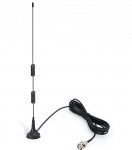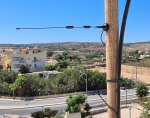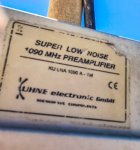The antenna in your picture and as you describe appears to be a cellular booster antenna even though it's clearly marketed as a scanner antenna. The designed frequencies are not typically those used when scanning (although 800 MHz is close). Also, the coax used is basically crap. It's RG-174 that is designed for very short jumpers inside equipment (think inches, not feet) and is very lossy. At 800 MHz you'll have 3dB of loss in that initial 10 foot section. Not good.
Any of those antennas linked above would be a much better solution. Don't get hung up on the "transmit" vs "receive" thing. Anything can be a receive antenna (it may not work well, but it will receive, even a straightened out paper clip!). Where it can transmit is important since that is the frequency range(s) where it's designed to work WELL (not just work). That is because a receiver takes whatever signal is present and tries to pull a signal out of it.
A transmitter has to work with an antenna that is designed for the frequency (more like frequency range) being transmitted and if you don't have a good match your transmitter will shut down (at best) or let the magic smoke out of the final transistors. On receive where there isn't a good match you get signal, but not much so you'll get noise or nothing but when the match is good, there will be maximum transfer of signal from through the antenna and you'll have a better chance of picking up enough signal for your scanner to actually allow you to hear the transmission.
With those antennas you'll be able to use whatever coax you want (horrible, bad, OK, good, or even great) from the antenna all the way down to the scanner. As expected, the better the coax, the more it will cost, but it's generally worth the cost. Don't worry about the connectors not matching your scanner since that's an easy fix. Just order your coax with the connectors needed on each end. They don't have to match! For example, say you got the Tram1411 from the first link. That has an SO-239 connector so your coax will need a PL-259 to connect to it. Assuming that you got the Bingfu since your scanner has a BNC antenna connector just ask them to put a male BNC on the other end of your coax. For most installs, a "good" coax would be some quality LMR-400 (get the name brand stuff like Times, not some LMR-400 "like" coax from eBay or some low-end Amazon sellers). Most places can custom make cables at the length you desire and install quality connectors of your choice. To show you the difference, using Times LMR-400 you'll have about the same loss for 100' as the RG-174 has in 10'. With a 40' piece (you'll want a little extra length - but not much - so you can work around duct work or other obstructions) you'll have less loss on your entire run that the Bingfu has in that 10' section.







